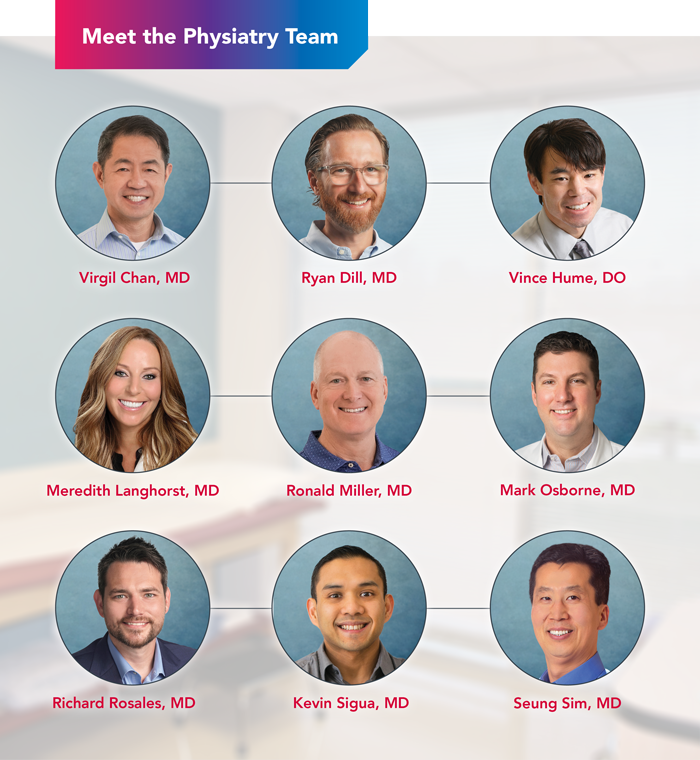The ultimate guide to
Non-surgical Orthopedic Care
Not all orthopedic injuries require surgery. This guide discusses when to see a physiatrist, how to avoid addictive pain medication and how to relieve pain without surgery.

This guide discusses...
Managing pain: An alternative to surgery and addictive pain medication
Living life in pain isn’t normal. Yet, for many people, pain is their constant reality. However, you don’t have to let pain stop you from living life. With a specialized treatment plan, there is hope of getting your normal back.
Whether you don’t think there is a solution for your pain, you are afraid of or not a candidate for surgery, or you don’t want to rely on addictive pain medication, our Ultimate Guide to Non-surgical Orthopedic Care discusses a different solution for your needs.
Let us help you get back to doing the things you love.
1 What is physiatry?
Physiatry, also known as physical medicine and rehabilitation or non-operative pain management, focuses on restoring a patient’s quality of life and physical abilities through the use of medication, therapy and minimally invasive procedures.
What is a physiatrist?
Physiatrists are medical doctors who have completed training in the specialty of physical medicine and rehabilitation. Physiatrists focus on how pain and physical limitations affect function and your daily quality of life. Through a thorough examination and appropriate diagnostic testing, they determine the best course of treatment for your condition.
Physiatrists can have subspecialty certifications in the following areas:
- Electrodiagnostics
- Interventional spine/pain management
- Traumatic brain injury
- Spinal cord injury
- Pediatrics
- Sports medicine
At OrthoIndy, our physiatrists also referred to as physical medicine and rehabilitation specialists or non-operative pain management doctors, focus on treating a multitude of medical, neurologic and orthopedic conditions in a non-operative approach.
OrthoIndy physiatrists’ interests include:
- Non-operative management of musculoskeletal injuries
- Non-operative spine care/interventional pain management
- Sports medicine
- Electrodiagnostic medicine
MEET THE ORTHOINDY PHYSIATRY TEAM
What kind of training does a physiatrist have?
Similar to an orthopedic surgeon, physiatrists must graduate from medical school followed by four additional years of residency training in a physical medicine and rehabilitation.
Many physiatrists choose to pursue additional advanced degrees known as fellowship training in a specific subspecialty area. Fellowships are available for specialized study in musculoskeletal rehabilitation, pediatrics, traumatic brain injury, spinal cord injury and sports medicine?
To become board certified in physical medicine and rehabilitation, rehabilitation physicians are required to take both a written and oral examination administered by the American Board of Physical Medicine and Rehabilitation (ABPMR).
What conditions does a physiatrist treat?
- Acute or chronic pain after an injury, illness or disabling condition
- Arthritis
- Back pain
- Complex regional pain syndrome (previously named reflex sympathetic dystrophy)
- Concussions
- Joint pain
- Musculoskeletal disorders
- Neck pain
- Pinched nerves
- Sciatica
- Scoliosis
- Sports injuries
SHOULD I SEE A SPINE SURGEON OR PHYSIATRIST FOR MY BACK PAIN?
2 When should you see a physiatrist?

How to cope with severe chronic pain
Everyone experiences pain at one time in their life or another. However, chronic pain is different. Chronic pain can linger for weeks, months or even years.
Learn how to manage chronic pain and begin to enjoy your life again.
If you are experiencing pain for an extended period of time, or you are under the care of a primary care physician and still experiencing pain, it might be time to seek help from a physiatrist.
Compared to a surgeon or pain medicine specialist, a physiatrist will give you different options to help you avoid surgery and addictive pain medication.
Signs you should make an appointment with a physiatrist
- You want to determine if you have the option to avoid surgery for your pain
- You have an injury or chronic condition that is taking a toll on your quality of life
- You were in an accident and it left you in pain
- You want a treatment that allows you to quit the addictive pain medication you’re on
- You want an option that avoids addictive pain medication altogether
- You have chronic pain from arthritis, a repetitive stress injury or back problems
- You were told you weren’t a candidate for surgery, but you are still in pain
Read about when you should visit a physical medicine and rehabilitation doctor (blog article)
3 What are your treatment options to avoid surgery?
Similar to any physician, a physiatrist will start by assessing your condition during your initial visit. During your first appointment or at a follow-up appointment he or she will develop a treatment plan tailored to your needs. Depending on your diagnosis, you may continue to meet with your physiatrist for a period of time.
Initial visit with a physiatrist
- A physical exam and medical history review
- Possible imaging tests such as an X-ray, MRI or CAT scan
- An evaluation of your symptoms
- A determination of your needs and goals

Physiatry treatment plan
Your treatment plan may include one or a variety of the following treatments:
- Use of medication
- Further diagnostic testing
- Referral to other specialists
- Involvement of a pain psychologist if you are dependent on pain medication
- Physical therapy
- Injection procedures using steroids or nerve blocks
- Ongoing monitoring and follow-up appointments
Procedures or services provided by physiatrists
- Epidural steroid injections: Can help relieve neck, arm, back and leg pain caused by inflamed spinal nerves due to spinal stenosis or disc herniation.
- Facet injections: Used to reduce the inflammation and swelling of tissue in and around the facet joint space in the spine.
- Joint injections: For the hips, shoulders or knees to relieve arthritic pain.
- Spinal cord stimulator trials: A device that is placed in the spinal canal to help manage arm or leg pain symptoms caused by nerve pain.
- EMG/Nerve conduction studies: A diagnostic test order to further evaluate how your nerves are functioning. Helps to grade the severity of an injury and helps give a better idea of prognosis of recovery for a given nerve injury.
- Non-opioid medication: Beneficial in helping to control chronic pain in conjunction with other treatment.
- Physician directed physical therapy: Used to strengthen and improve functional activity and quality of life in conjunction with other treatment.
- Trigger point injections: Used in the treatment of painful/tender muscle areas that contain trigger points.
READ ABOUT WHAT TO EXPECT DURING A VISIT WITH A PHYSIATRIST (Blog Article)
4 How can you avoid or quit addictive pain medication?
The United States uses more opioids than any other country in the world. The opioid epidemic started with physicians simply wanting to do the best thing for their patients, relieve their pain.
However, pain is complex and not all pain needs to be addressed by using opioids or other addictive pain medication.
OrthoIndy physiatrists aim to treat conditions in a non-operative manner through the use of non-opioid medication, therapy and minimally invasive procedures.
Although physiatrists do not perform traditional surgery, it is important to note that they do not heavily rely on addictive opioid pain medication to treat patients. In fact, it’s the opposite.
How can a physiatrist help you avoid opioid medication?
Managing pain without opioid use is exactly the service that OrthoIndy physiatry provides. The physiatry team focuses on a treatment plan that allows the patient to return to their pre-injury activity levels without relying on opioid pain medication.
Physical dependence on opioids can occur when a patient has received opioids for a long period of time. To avoid depending on opioids or becoming addicted to opioids it is best to follow a physician’s orders and ask questions if you feel uneasy about an opioid prescription.
WATCH VIDEO: Alternative ways to heal without the use of pain medication

How to avoid or quit addictive pain medication
With the opioid crisis in the United States, it’s important to be educated on what opioids are, how you can avoid opioid addiction, how to safely quit opioid use and what to expect after quitting addictive pain medication.
Questions to ask if you are prescribed opioids
- Is there any way I can avoid or delay opioids for my pain?
- Is my prescription the lowest effective dose for the shortest period necessary?
- When can I expect to stop taking opioids for my pain?
- Will this prescription help me reach my goals to live a normal pain-free life?
- How often can I meet with you for a follow-up appointment?
- How can I minimize withdrawals when I stop opioids?
How to safely quit opioid pain medication
Never quit opioids cold turkey on your own. Not only could it put you at a risk for failure, but there are also various serious health consequences.
Signs that it’s time to stop opioid medication use
- Serious physical side effects
- Mood changes
- Reduced pain relief
- Misuse, abuse or addiction
- Accidental overdose
Steps to safely quitting opioid pain medication
- Develop a medication withdrawal plan with a doctor
- Realize it will take time
- Don’t give up
- Learn alternative ways to cope with pain
READ ABOUT OPIOID PAIN MEDICATION AND WHY IT ISN’T THE ANSWER (BLOG ARTICLE)
Common prescription opioids
- Codeine
- Fentanyl
- Hydrocodone (Vicodin®)
- Oxycodone (OxyContin®, Percocet®)
- Morphine (Kadian®, Avinza®)
- Oxymorphone (Opana®)
- Ultram (Tramadol)
Ask your doctor if you don’t know whether your painkiller is an opioid.
5 How OrthoIndy works as a team to help you get normal back
Sometimes a patient will work solely with their physiatrist or other times they may seek the care of a variety of providers. A physiatrist is trained to lead care and coordinate with a team of specialists.
OrthoIndy physiatrists work with
OrthoIndy Physical Therapy: Physiatrists work with physical therapists to develop specialized treatment plans for their patients to strengthen their muscles and increase range of motion. Treatment plans may include exercise, stretches or dry needling.
Orthopedic Surgeons: For a variety of reasons, non-surgical treatment may fail to provide patients with satisfactory results. A surgical referral may then be the appropriate next step.
OrthoIndy Urgent Care: Physiatrists help treat patients as they come into the urgent care for various pain. They help diagnose patients and determine the best course of treatment.
OrthoIndy Research: Physiatrists are constantly looking for ways to improve their practice and results for their patients. New research studies allow physiatrists to trial new products that may alleviate pain for their patients.
READ WHAT MAKES THE PRACTICE OF PHYSIATRY A TEAM APPROACH (BLOG ARTICLE)
The OrthoIndy Physical Therapy team helps patients rehab faster to return to their normal activities. Physical therapists work with OrthoIndy physiatrists and surgeons to come up with a specialized treatment plan to treat orthopedic related pain, conditions or injuries.
6 Physiatry Resources
Guides
- The ultimate guide to non-surgical orthopedic care
- How you can avoid or quit addictive pain medication and return to an active lifestyle
- How to cope with severe chronic pain
Blogs
- When should I visit a physical medicine and rehabilitation doctor?
- Understanding opioid pain medication and why it isn’t the answer
- What to expect during a visit with a physiatrist
- What makes the practice of physiatry a team approach?
Videos
- Injection
- Alternative ways to heal without the use of addictive pain medication
- Common concerns and treatment options with a physiatrist
- Patient story: Giving up pain pills allows patient to find back pain relief
Physiatry treatment at OrthoIndy
With years of experience and the most advanced technology, OrthoIndy physiatrists will give you the best chance possible to achieve your goals. Make an appointment and let OrthoIndy’s team of experts help you get normal back, whatever your normal looks like.




